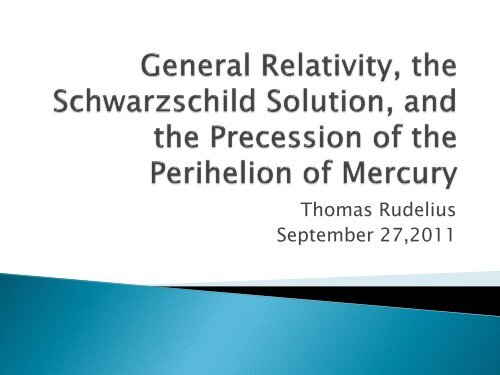General Relativity, the Schwarzschild Solution, and the Precession ...
General Relativity, the Schwarzschild Solution, and the Precession ...
General Relativity, the Schwarzschild Solution, and the Precession ...
You also want an ePaper? Increase the reach of your titles
YUMPU automatically turns print PDFs into web optimized ePapers that Google loves.
Thomas Rudelius<br />
September 27,2011
Some familiar examples of line elements:
These metrics have signature (3,0) <strong>and</strong> (2,0),<br />
respectively.<br />
In relativity, our “metric” has signature (3,1)
A particle moves in space-time along a path<br />
that extremizes <strong>the</strong> proper time<br />
T<br />
For special relativity,<br />
x
Typically, we set G = c = 1.
For sufficiently large r/sufficiently small M,<br />
Setting<br />
We get
So,<br />
Exp<strong>and</strong>ing to first order in <strong>the</strong> velocity
In classical mechanics, particle moves to<br />
extremize action,<br />
Setting<br />
We get same expression, up to negligible<br />
constants
We could write out all <strong>the</strong> Christoffel symbols<br />
<strong>and</strong> calculate that way.<br />
Instead, we exploit symmetries (Killing<br />
vectors)<br />
Planar motion, set
If <strong>the</strong> line element is independent of a<br />
coordinate (t <strong>and</strong> φ here), we get a conserved<br />
quantity from taking <strong>the</strong> inner product
We have <strong>the</strong> identity,<br />
Plugging in e <strong>and</strong> l,<br />
We get a 1-D problem
Rearranging terms, we find<br />
where
Compare this expression to that for<br />
Newtonian mechanics,<br />
Identical except for an O(r -3 ) correction,
Solving for extrema of <strong>the</strong> potential gives<br />
Can show
http://physics.ucr.edu/~wudka/Physic<br />
s7/Notes_www/node98.html
The precession of <strong>the</strong> perihelion of Mercury is<br />
measured to be 5600 arc seconds per<br />
century.<br />
Newton’s equations, accounting for<br />
gravitational interaction with o<strong>the</strong>r planets,<br />
Mercury’s rotation, <strong>and</strong> <strong>the</strong> fact that Earth is<br />
not an inertial reference frame, predicts 5557<br />
arc seconds per century– off by 43.<br />
GR accurately accounts for discrepancy.
Recall,<br />
Yielding,
Solving to lowest order in c 2 gives,
Recall that our coordinates break down at<br />
r=2M.<br />
Can eliminate this by introducing new<br />
coordinates:
No more singularity at r = 2M<br />
Light rays travel at 45º angles in U-V diagram
Otto
Questions
Hartle, James B. Gravity: An Introduction to<br />
Einstein’s <strong>General</strong> <strong>Relativity</strong>. San Francisco:<br />
Addison Wesley, 2003.<br />
McAllister, Liam. Physics 4445 Lecture Series,<br />
2010.<br />
“<strong>Precession</strong> of <strong>the</strong> perihelion of Mercury,”<br />
http://physics.ucr.edu/~wudka/Physics7/Not<br />
es_www/node98.html

















